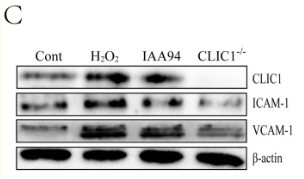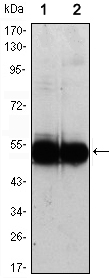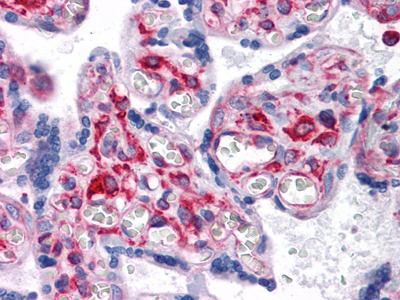VCAM-1 Monoclonal Antibody
- Catalog No.:YM0644
- Applications:WB;IHC;IF;ELISA
- Reactivity:Human
- Target:
- VCAM-1
- Fields:
- >>NF-kappa B signaling pathway;>>Cell adhesion molecules;>>TNF signaling pathway;>>Leukocyte transendothelial migration;>>AGE-RAGE signaling pathway in diabetic complications;>>African trypanosomiasis;>>Malaria;>>Lipid and atherosclerosis;>>Fluid shear stress and atherosclerosis
- Gene Name:
- VCAM1
- Protein Name:
- Vascular cell adhesion protein 1
- Human Gene Id:
- 7412
- Human Swiss Prot No:
- P19320
- Mouse Swiss Prot No:
- P29533
- Immunogen:
- Purified recombinant fragment of human VCAM-1 expressed in E. Coli.
- Specificity:
- VCAM-1 Monoclonal Antibody detects endogenous levels of VCAM-1 protein.
- Formulation:
- Liquid in PBS containing 50% glycerol, 0.5% BSA and 0.02% sodium azide.
- Source:
- Monoclonal, Mouse
- Dilution:
- WB 1:500 - 1:2000. IHC 1:200 - 1:1000. ELISA: 1:10000.. IF 1:50-200
- Purification:
- Affinity purification
- Storage Stability:
- -15°C to -25°C/1 year(Do not lower than -25°C)
- Other Name:
- VCAM1;L1CAM;Vascular cell adhesion protein 1;V-CAM 1;VCAM-1;INCAM-100;CD antigen CD106
- Molecular Weight(Da):
- 81kD
- References:
- 1. Cell Adh Migr. 2009 Oct;3(4):369-72.
2. Arthritis Rheum. 2010 Jan;62(1):105-16.
- Background:
- This gene is a member of the Ig superfamily and encodes a cell surface sialoglycoprotein expressed by cytokine-activated endothelium. This type I membrane protein mediates leukocyte-endothelial cell adhesion and signal transduction, and may play a role in the development of artherosclerosis and rheumatoid arthritis. Three alternatively spliced transcripts encoding different isoforms have been described for this gene. [provided by RefSeq, Dec 2010],
- Function:
- alternative products:Additional isoforms seem to exist,disease:May play an important role in the genesis of atherosclerosis and rheumatoid arthritis.,domain:Either the first or the fourth Ig-like C2-type domain is required for VLA4-dependent cell adhesion.,function:Important in cell-cell recognition. Appears to function in leukocyte-endothelial cell adhesion. Interacts with the beta-1 integrin VLA4 on leukocytes, and mediates both adhesion and signal transduction. The VCAM1/VLA4 interaction may play a pathophysiologic role both in immune responses and in leukocyte emigration to sites of inflammation.,induction:By cytokines (e.g. IL-1, TNF-alpha).,online information:VCAM-1,online information:VCAM1 entry,PTM:Sialoglycoprotein.,similarity:Contains 7 Ig-like C2-type (immunoglobulin-like) domains.,subunit:Binds to ECMV-D capsid proteins and acts as a receptor for this virus.,tissue specificit
- Subcellular Location:
- Membrane; Single-pass type I membrane protein.
- Expression:
- Expressed on inflamed vascular endothelium, as well as on macrophage-like and dendritic cell types in both normal and inflamed tissue.
Cytotoxicity of mesoporous silica modified by amino and carboxyl groups on vascular endothelial cells. ENVIRONMENTAL TOXICOLOGY Environ Toxicol. 2021 Jul;36(7):1422-1433 WB Human 1 : 1000 HUVECs
- June 19-2018
- WESTERN IMMUNOBLOTTING PROTOCOL
- June 19-2018
- IMMUNOHISTOCHEMISTRY-PARAFFIN PROTOCOL
- June 19-2018
- IMMUNOFLUORESCENCE PROTOCOL
- September 08-2020
- FLOW-CYTOMEYRT-PROTOCOL
- May 20-2022
- Cell-Based ELISA│解您多样本WB检测之困扰
- July 13-2018
- CELL-BASED-ELISA-PROTOCOL-FOR-ACETYL-PROTEIN
- July 13-2018
- CELL-BASED-ELISA-PROTOCOL-FOR-PHOSPHO-PROTEIN
- July 13-2018
- Antibody-FAQs
- Products Images

- Xu, Yingling, et al. "CLIC1 inhibition attenuates vascular inflammation, oxidative stress, and endothelial injury." PloS one 11.11 (2016): e0166790.

- Western Blot analysis using VCAM-1 Monoclonal Antibody against HUVEC (1) and EC (2) cell lysate.

- Immunohistochemistry analysis of paraffin-embedded human Placenta tissues with AEC staining using VCAM-1 Monoclonal Antibody.



